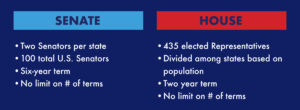Levels of Government
The U.S. Government is organized into three categories:

Federal
The main body of government in the United States that makes laws and policies that apply to all states. It is divided into three branches of power to ensure that no individual or group overpower the other: the legislative branch (Congress), the executive branch (the President) and the judicial branch (Federal Courts).
Under the Tenth Amendment, all powers not granted to the federal government are reserved for the states and its people.
State
Modeled after the Federal Government with the same three branches (executive, legislative, judicial), the State Government has broad power in creating laws and policies that apply to the whole state.
City
The most local form of government that is led by the Mayor and Council (which has 51 members).
Check out this handout from Learning for Justice that shows which level of government is responsible for making decisions that affect your life
Three Branches of the United States Government
The United States Constitution separates the federal government into three parts (branches):
- Legislative
- Judicial
- Executive

Having three branches ensures that any one group or person does not have too much power. This is known as a system of checks and balances. All states are organized by the model of the Federal Government with the three branches, though a three-branch system is not required.
Video
The Legislative Branch
The Legislature, called Congress, is the law-making branch of the U.S. government that drafts and proposes laws; confirms or rejects presidential nominations for heads of federal agencies, federal judges, and the Supreme Court; and has the authority to declare war.
Congress has two chambers: the House of Representatives and the Senate.
House of Representatives
There are 435 elected Representatives, which are divided among the 50 states in proportion to their population. This means that larger states have more Representatives and smaller states have fewer. A Representative serves a two-year term, and there is no limit to the number of terms that they can serve.
Senate
There are two elected Senators per state – totaling 100 senators. A Senate term is six years and there is no limit to the number of terms a Senator can serve.

The Executive Branch
The Executive Branch carries out and enforces the laws of the U.S. Government and includes:
The President
This person leads the country and they are the head of state, leader of government, and Commander in Chief of the armed forces.
- The President serves a four-year term and can only serve for two terms.
- To become President, a person must have been born in the U.S., must have lived in the U.S. for at least 14 years, and must be at least 35 years old.
- The President has the power to sign bills into law and to veto or reject bills that come to their desk. However, a two-thirds majority of both the House of Representatives and the Senate can overturn a presidential veto.
The Vice President
This person is second in command to the President.
- If the President dies, resigns, is impeached, or unable to fulfill their duties, the Vice President takes over their position.
- The Vice President is the president of the Senate and can vote on bills only if the Senate is equally divided.
- They can be elected and serve an unlimited number of four year terms as Vice President even under a different president.
The Cabinet
Members of the Cabinet are nominated by the President and must be approved by the Senate. Cabinet Members then serve as advisors to the President and they include the Vice President, heads of executive departments, and other high-ranking officials. Some examples of Cabinet Members include the Secretary of State, Secretary of Education, and the Secretary of the Treasury.
The Judicial Branch
The Judiciary is the branch that interprets the meaning of laws, applies laws to individual cases, and decides if the laws operate in accordance with the U.S. Constitution. It includes the Supreme Court and other federal courts.
Supreme Court
The highest court in the United States. There are nine Justices on the Supreme Court that are nominated by the President and must be approved by the Senate. Once approved, Supreme Court Justices keep their positions in office for life – unless or until they die, resign, or are impeached and convicted by Congress.
Sources
“Annenberg Civics Knowledge Survey.” Annenberg Public Policy Center. https://www.annenbergpublicpolicycenter.org/political-communication/civics-knowledge-survey/.
“Branches of the U.S. Government.” Usa.Gov. https://www.usa.gov/branches-of-government.
“Federal Government.” Ballotpedia. https://ballotpedia.org/Federal_government.
“Glossary of Terms.” Annenberg Classroom. https://www.annenbergclassroom.org/resource/glossary-of-terms/#section-c.
“State and Local Government.” The White House. https://www.whitehouse.gov/about-the-white-house/our-government/state-local-government/.


 Make the Switch to our new mailing list!
Make the Switch to our new mailing list!